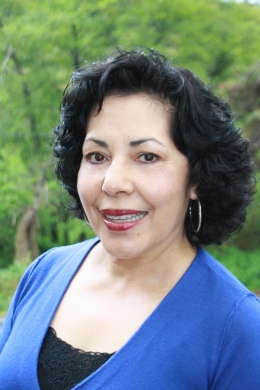 2014, 133 pages
2014, 133 pages
To read the full text [PDF] of Crossing Borders, Crossing Words: An Oral History of UC Santa Cruz Professor Olga Nájera-Ramírez [UC Escholarship Version] Includes complete audio (streaming or download) for the oral history. Note: Due to editing by the narrator and the Project, there may be minor differences between the audio recording and the transcript. Please quote from the transcript as the record and not the audio. Audio will be found under "Supporting Material."
Olga Nájera-Ramírez was born in 1955 and raised in the small town of Davenport, California. She is the fourth of six children. In the early 1950s, her parents came to the United States from the state of Durango, Mexico, part of a migration of Mexican-Americans to the North Coast of Santa Cruz County. Her father worked in the fields and at the Davenport Cement Plant. When Nájera-Ramírez was eight, her father died and her family labored in the fields along with finding other jobs to support themselves. Her mother worked in packing sheds and canneries in several places in Santa Cruz County. This oral history begins with Nájera-Ramírez’s recollections of growing up in Davenport. Nájera-Ramírez’s early labor as a farmworker and the importance she placed on creating familia within the community in Davenport grounds her later vision of facilitating access to the university system for people of diverse locations.
Even as a small child in Davenport, Najera-Ramírez was interested in becoming a teacher. Her high school counselor held what Nájera-Ramírez’s termed “a paternalistic view of the minorities” and discouraged her from pursuing an advanced education in academia. But Nájera-Ramírez persevered, and despite a lack of mentors or even financial advising, became the first in her family to attend a four-year college, entering UC Santa Cruz as a student in Merrill College in 1973.
As a UCSC student, Najera-Ramírez danced with Los Mejicas which galvanized what would become a lifelong interest in conducting research on the dance and traditions of Mexico and Mexican folklore. She earned a dual degree in history and Latin American studies from UC Santa Cruz in 1977. Nájera-Ramírez remembers the Chicano/Latino graduation feeling like a family party—this speaks simultaneously to the small numbers of Chicanas and Latinos graduating in 1977, as well as to importance of music, food, and cultura within a university setting to sustain people of color. Her recollections of Chicano/a Latino/a life at UCSC in the 1970s, as well as her faculty mentors and classes, are an invaluable contribution to a little-documented aspect of UCSC history.
Najera-Ramírez's involvement with Los Mejicas during her undergraduate career in 1976 gave her the opportunity to meet Rafael Zamarripa, a well known folklorico maestro, in Colorado. As a result of this life-altering meeting, Najera-Ramírez decided to attend University of Guadalajara and further study dance. After three years, she returned to the United States and attained her MA in Latin American Studies from the University of Texas in 1983. She also married her husband, Ronaldo Ramírez in that year. In 1987, Najera-Ramírez earned her PhD in anthropology from the University of Texas, with a specialization in folklorico studies.
Nájera-Ramírez is perhaps unique among UCSC faculty in that she is a native of Santa Cruz County who attended UC Santa Cruz, and then returned to her alma mater for a lifelong career as a tenured professor. In 1989, Nájera-Ramírez was hired by UCSC’s anthropology department, where she has now taught for twenty-five years. She is also a founder of UCSC’s Latin American and Latino Studies department and has directed the Chicano/Latino Research Center (CLRC). Striking in Nájera-Ramírez’s interview is her dedication to communities of color who are producing knowledge of “Greater Mexico” and beyond. This is evident primarily through her mentorship of graduate students of color, active guidance of Los Mejicas, and participation in cross-border projects of the CLRC.
Along with being a published writer, Olga is a film producer who has created two major films, La Charreada: Rodeo a la Mexicana and anza Folklórica Escénica: El Sello Artístico de Rafael Zamarripa (Mexican Folkloric Dance: Rafael Zamarripa’s Artistic Trademark). She describes the making of these two films in her oral history and demonstrates her dedication to visual arts and culture.
Najera-Ramírez has also served as the faculty advisor for Grupo Folklórico Los Mejicas of UCSC since 1997, which has been dancing folklorico since 1972. Los Mejicas fosters a strong sense of community at UCSC, thereby helping with the retention of Chicano/a and Latino/a students. The group performs at public schools throughout California and in the process does outreach to potential UCSC students of all cultural and ethnic backgrounds.

 Santa Cruz, CA
Santa Cruz, CA



